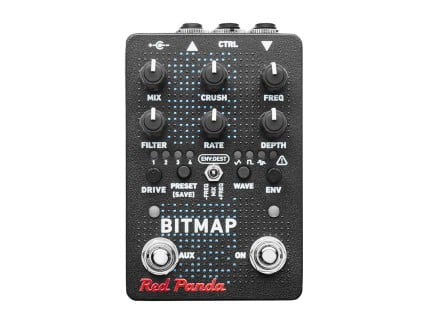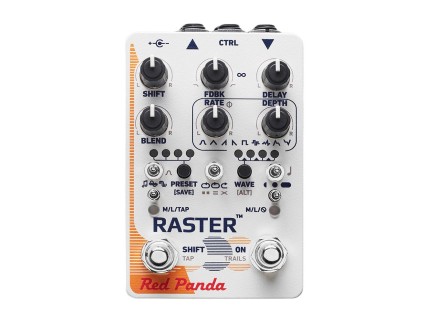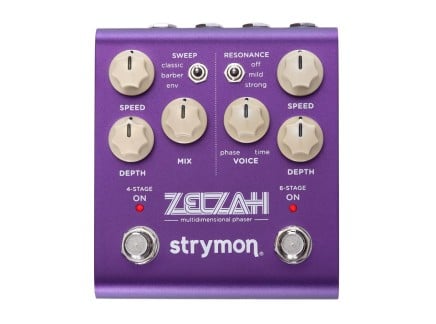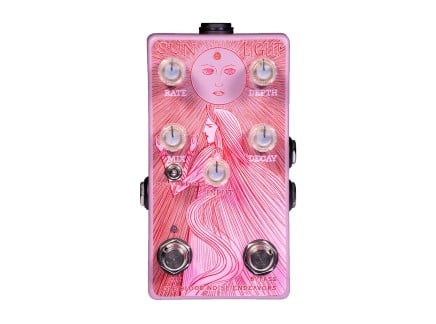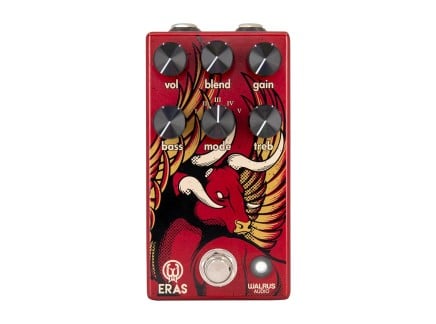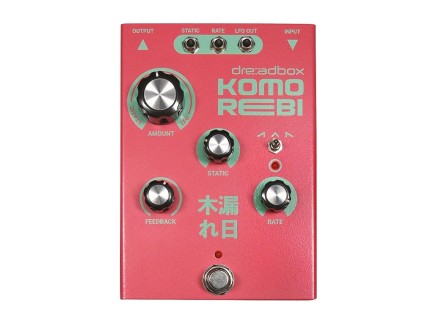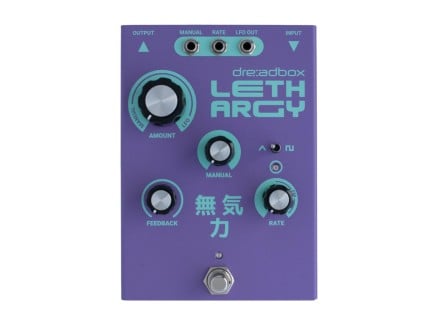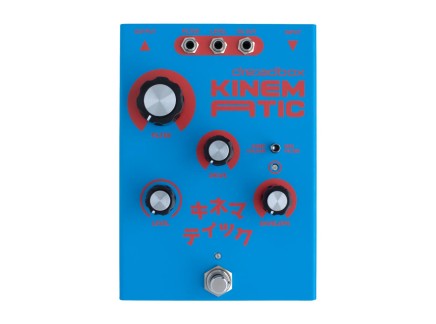As we've said before, 2021 has been an amazing year for new gear; we've discussed this extensively in other recent articles, including our staff picks for the best synths and modular gear from the past year. But we've gotta say it—while it's been a cool year for synths, it's been equally exciting to watch developments in the world of effect pedals.
Several of us on Signal's staff have revitalized our personal relationship with effect pedals in the last year; a couple of us have picked up the guitar again after a long hiatus, and yet others have been exploring different ways of combining pedals with synths, drum machines, bass, and more. As such, we've coincidentally formed a strong bond with many new pedals this year, and have been trying our luck seeing just how far they can all be pushed. Narrowing down to this list was a bit tough, so we've each elected to pick a couple of our favorite new effect pedals—and whether you play guitar, synths, or are outfitting a studio, we think each of these recommendations has something unique and fun to offer. Let's dive in!
Ryan's Picks: Red Panda's Bitmap 2 + Raster 2
Now having updated their entire product line to a new form factor and a new standard of overall flexibility and sonic fidelity, Red Panda no doubt have one of the most powerful, characterful, and overall brilliant selections of any pedal brand, period. Each pedal is like its own little universe—exploring a single effect concept and pushing it as far as it could possibly go. In the currently lineup—the second revision of most pedals—this means stereo I/O on all models, extensive MIDI implementation, clever external control schemes, and a sound that rivals high-end studio effect units.
This year, they released the Bitmap 2 and Raster 2: each long-awaited updates to pedals that already held a dear place in our hearts. Like all Red Panda devices, they work great with guitars, bass, drum machines, synthesizers, or basically any instrument or line-level signal...so don't let the fact that they take the form "guitar pedals" deter you from exploring their potential with other sound material as well.
Bitmap 2 is a comprehensive set of sample rate reduction, bit depth reduction, overdrive, waveshaping, and filtering effects: the ultimate bitcrusher. It offers continous sample rate reduction from 48kHz down to 110Hz and fractional (yes, fractional!) bit reduction from 24-bit down to 1-bit. This means that you can accomplish an incredible array of downsampling/bitcrushing effects from subtle high-end aliasing to completely crushed, insane inharmonic fuzz tones. In addition to that, Bitmap 2 features controllable drive (great for boosting lower-level sources), as well as selectable waveshaping and wavefolding functions for a special flavor of synth-like dynamic snarl. The crushed/distorted signal passes through a 4-pole filter model, helping you tame its harsh, clangorous tones.
Bitmap 2 also features a comprehensive internal modulation scheme. A multi-waveshape LFO provides triangle, square, and stepped random modulation of the sample rate or mix controls, allowing for automated swells, divebombs, or jarring, stuttering distortion effects. A built-in envelope follower allows you to dynamically control the sample rate or mix in conjunction with your playing, for a wide range of bizarre triggered, responsive modulation effects. Additional modulation options are also available via MIDI or via Red Panda's web editor...for instance, these means of external control offer a considerably wider range of options for interacting with the Filter. Via MIDI or web editor, you can adjust filter resonance, modulation, and much more. And once you've dialed in your preferred settings, Bitmap offers dedicated access to up to four internal presets (or up to 127 via MIDI), so once you've dialed in a complex patch or a patch that relies on parameters not accessible via the front panel alone, you can still access it when needed. So, despite the fact it might look unassuming from the front panel, Bitmap 2 might just be one of the most interesting bitcrushers ever made. It'll make you realize just how useful a bitcrusher can be in a variety of situations, from emulating the sound of old samplers all the way to intense, jarring, yet pleasantly interactive modulation. Even if bitcrushing isn't part of your usual go-to bag of tricks, this pedal is well worth a try.
And then, there's Raster 2: the long-awaited update on Red Panda's cult classic pitch shifted delay pedal. Raster 2 takes the concepts of the original miles farther, and in many ways could be thought of as a full instrument in its own right. It's insane.
At its core, Raster 2 is a mono or stereo delay with an additional built-in pitch shifter/frequency shifter—and both the delay and shifting sections have an extensive range of parameters, a number of means of interacting with one another, and a variety of options for independent manipulation in both halves of the stereo field (but don't worry—it's still a blast to use in mono). The feedback control is very intentionally scaled to make it easy to dial in infinite repeats; this makes it easy to use as a sort of micro-looper where the same sounds repeat indefinitely. Or, alternatively, you can push the feedback into higher regions and listen as your tone evolves into pleasantly distorted repeats; the choice is yours!
Raster 2's shifting functions have three modes: a semitone-quantized pitch shifter, a continuous pitch shifter, and a phase/frequency shifter. The shifter can be placed within the feedback loop for continuously cascading, kaleidoscopic shifting effects (think Rainbow Machine or classic shimmer-style effects), or it can be placed after the delay line, shifting all repeats by a fixed amount. The quantized mode is perfect for arpeggiated symmetrical harmonies, while the detuned/continuous mode can be employed for classic "micropitch" style effects and more clangorous evolving tones. The frequency shift mode is a personal favorite, creating echoes that gradually deform as they ring out, creating something not dissimilar to a cascading ring modulation effect.
All primary parameters allow for an offset between the left and right channels—so you can, for instance, have different delay rates, feedback amounts, shift amounts, or modulation settings in the left and right channels. You also have the option for series, parallel, and ping pong delay modes, allowing for a huge range of effects from spinning stereo image to pseudo-multitap delays and much more. Even if used with a mono input, it's possible to create an enormous range of animated stereo textures. It also features an even more extensive modulation section than Bitmap, employing an LFO with seven selectable wave shapes as well as envelope follower options. These internal modulation sources can affect the effect's amplitude, delay time (for classic vibrato, chorus, and doppler effects), or shift amount. You can even alter the phase of the modulation for each delay channel relative to one another, making it possible for each side of the stereo field to modulate to different values from another, or in completely different directions: increasing the number of options for stereo manipulation exponentially.
Frankly, Raster 2 is much too deep to cover entirely in the scope of this short article—but in short, it's one of the best delay pedals we've ever used, and frankly one of the best we've ever even heard of. Packing basically all of my personal favorite delay manipulation tricks into a single box, it's basically the delay of my dreams: a delay with swirling stereo motion, integrated pitch and frequency shifting, and an enormous range of control options both internal and external. It's incredible, and if you're a musician looking for an inspiring, creative delay effect, I'm sure you'd be happy stopping your search and picking up a Raster 2.
Iain's Picks: Strymon Zelzah + OBNE Sunlight
My favorite pedal of the year has to go out to the Strymon Zelzah, a flexible and dual channel phaser that not only achieves the classic phaser sounds from the early 70s, but also incorporates ingenious methods for achieving a wide range of modulation effects. Each channel contains its own unique effect, so you're basically getting two pedals in one with a palette of sonic colors to choose from. With flexible routing, multiple options for stereo response, and fully spec'd out MIDI implementation, Zelzah could become your most versatile modulation pedal for your pedalboard or studio.
Looking at Zelzah's foundation, we can find that the two pedal modes include four and six stage phasing, each having individual control over depth and speed of modulation as well as a unique control. Zelzah's four stage mode offers three flavors of sweeping, including classic for your typical triangle-esque frequency sweep, barber for continuous rising and falling of frequency, and env for envelope following the frequency via the incoming audio. Each mode has its own character and use case, but I quite enjoy the env mode on a bass synth for bringing lively and talkative nature to an otherwise stagnant sound. The mix control really determines how the effect will work, with 0% giving you no effect, anywhere before 100% giving you phaser-like tones, and at 100%, you can achieve vibrato and tremolo-like effects based on the sweep mode.
Moving your attention to the six stage mode, we see the main differences include a three-way resonance switch and a "voice" control. When engaging the 6-stage, you can't balance a mix, so instead you have control over how strong the resonance is, with options for none, mild, and strong. Engaging the resonance can emphasize the phasy-ness, but pairing that with offsetting the voice knob can actually get you further down to flanger and chorus territories. The voice knob achieves this deviation via intelligently tuned all-pass filters that shift in the time domain rather than delay-lines, so it's a very unique yet similar sound to their intended effect. Setting the resonance to strong and turning the voice upwards at noon can get some killer flangers that wail.
With the ability to use them simultaneously, you have a multitude of sonic possibilities for adding movement and depth to your sounds. Normally the two effects run in series where the six stage runs into the four stage, but with some extra pushes and turns, you can run them in parallel. What makes the routing even wilder is when you start introducing the stereo field, in which series and parallel can be processed as two copies, or you can split them up so the four stage runs on the left and the six stage runs on the right. To push this even further, the input can process stereo information via a TRS input, making the ability to process the stereo field even grander. The possibilities for modulation seem endless for the Zelzah, and the only limitation is your imagination.
Another pedal I found surprisingly useful and creative this year was the newly released Sunlight from Old Blood Noise Endeavors, a reverb that dynamically sustains with multiple flavors of modulation. My original misunderstanding came from using highly static or overly dynamic material, thinking Sunlight just wasn't the right pedal for me. However, after revisiting it, spending time to understand each control better, I realized how versatile Sunlight can be not only on guitar but also on synths and drum machines. That said, if you're looking for ways to add brilliant, warm, and exciting textures to your pedal rig or collection of effects, Sunlight has a variety of means to fill that void.
Looking solely at its main feature, Sunlight provides a wonderful mono reverb that has a decently long tail even with Decay all the way down. When increasing Decay, you lengthen the tail of the reverb all the way to infinity when at maximum, and keeping Sunlight's reverb intriguing and changing lies in what you feed it. Sunlight will hold your last note or sonic activity for as long as Decay is set, and once new information passes through, the reverb begins to focus on that material and gently removes the previous reverb tail. Related to Decay, setting the Input control not only sets the gain of the incoming signal but also determines how sensitive the response to Sunlights dynamic reverb. Of course Sunlight is brilliant for making pads and drones that hang out for asynchronous pleasures, but even throwing it after arpeggios and plucked information can be a great tool for filling out the space or making interesting leads.
The three modes of Sunlight offer distinct and individual takes on modulated reverb with routings that can sound anywhere from super washy to wiggly and jumpy. Starting at the left notch, Tape mode presents a quite lop-sided LFO which applies warble to the reverb such as a faulty tape would, where the Rate and Depth controls determine the speed and amount of modulation. Placed after the reverb, Tape mode can get you subtle shifts, interesting choruses, or even wild and sickening bends. Moving to Comb mode, Sunlight's reverb now passes through a set of four harmonically related delays which can go into comb filtering ranges the farther CCW you push the Rate. Meanwhile, Depth will determine the feedback of the delays, which can create resonance for the stasis comb filtering or almost self-oscillating feedback. Finally, Sunlight's Pass mode features a band pass filter after the reverb and is then again sent to another reverb, offering sweet poking bubbles of resonant goodness passing once again into a lovely space. With Rate all the way down, the Depth control sweeps the frequency range as a normal band pass, but when engaging Rate, you slowly start to introduce a sample & hold LFO over the frequency cutoff while Depth becomes a bias control over how far the LFO sweeps the filter.
As great as Sunlight is to set and forget, OBNE presents you with a couple alternatives for getting even more out of your pedal. The Alt footswitch engages a second set of knobs definable to your liking, setting the position of any combination including Rate, Depth, Decay, and Input. This feature is great for hitting a certain effect or even canceling out your input to shred without affecting the reverb. Additionally, these same parameters can be modulated via the expression input, where you can set individual heel and toe positions for sweeping through. I think it's really important to fully explore the capabilities of gear before knocking it, and having done so with OBNE's Sunlight has made me more aware of not only stretching gear to its limits, but also finessing gear to work for you.
Jacob's Picks: Walrus ACS1 + Eras
2021 was the year I began seriously playing the guitar again, and what a time to come back. While I had not stopped using pedals in my five year break, coming back to this ever-expanding world of sonic bliss with my ears once again tuned for guitars was refreshing, and brought a lot of pedals onto my radar that I wouldn't have previously considered for synth-only purposes. Everything from garden-variety overdrives and distortions to new takes on tremolo, phasers, and more, even all the way up to the powerful modelers and multi-effects—so many of these things are naturally designed to sound great with the guitar, and thus can be used to their fullest potential with the instrument they were intended for.
One thing I haven't missed about playing the guitar is dealing with amps—as much as I'd love to fire up a tube amp and let it rip, living in an apartment doesn't make this very practical for reasons of space and noise. Thankfully there's a number of great plugins, modelers, and dedicated amp/cab simulators out there today, but perhaps my favorite to come out this year was the ACS1 from Walrus Audio. This entry in their growing Mako series of stereo, MIDI-capable pedals serves to fill the need of completing an all-in-one pedalboard and eliminates the need to use an amp entirely, something which is becoming increasingly common in a few circles of the guitar-playing world.
ACS1 aims to be as similar to using a real amp as possible, providing Volume and Gain controls alongside a three-band EQ, with three different amp models and six total cabinets available. The amps themselves are based upon the classic trinity of Fender, Marshall, and Vox designs, but should you crave some high-gain fury (more on this below), Walrus tuned the ACS1 to accept drive pedals in front of it exceedingly well. But possibly the coolest thing about this pedal isn't just the onboard boost, MIDI control, or the ability to swap out the cab IRs: it's the fact that it's fully stereo and amps may be set to entirely different settings on the left and right audio channels. Simply flip the middle toggle switch to L or R and adjust the respective amp, even switching the models and cabinets if desired, and pop it back to the middle for uniform changes between both sides. In headphones this can be a bit disorienting with the resulting phase cancellation, but in recording situations or dual-mono configurations within a live setup, it can add another layer of depth to your guitar tones.
Walrus Audio didn't stop with the ACS1 this year though, and pulled out all the stops for their ferocious, high-gain monster: Eras. This five-mode beast bears functional resemblance to their previous multi-voice pedal Ages, but with much more gain on tap for searing leads and crushing riffs. But even if you're not a guitarist, Eras might still have some appeal for you thanks to the inclusion of a Blend control. With synthesizers, drum machines, and the like, I personally prefer to blend distortion in with the dry signal to maintain clarity and a full-bodied frequency spectrum, and that's an easy thing to accomplish in the studio but would otherwise require some planning and extra components to be part of a hardware-based setup. But by including a Blend control on Eras, Walrus has ensured that this distortion effect can fit into your chain just as easily as any other pedal.
With both the ACS1 and Eras in hand, any guitarist would have the means to craft an expansive range of tones. Whether you're seeking classic sounds suited for the comfort of your own home or need a single pedal to deliver thick and heavy tones at an instant, Walrus proved they easily could deliver both in 2021.
Brian's Picks: Dreadbox New Releases
Dreadbox's bold colors and excellent design have caught our attention, but the sound and playability is what has kept us around. They announced several new effects pedals this year—but three in particular have piqued our attention: the Lethargy 8-stage phaser, Komobebi chorus/flanger, and Kinematic compressor/filter. These pedals all contain exceptionally handy 1/8" CV patch points which makes integrating them into your Eurorack easy, your modulation sources consistent for your guitar chain and your synth chain a breeze, or use the points to patch them all together for some wild fun.

The Kinematic is broken up into two modes: one for Filter and another for Compression. Both are playable and sound great, but have slightly different knob functions. The Filter knob is a frequency boost—similar to a bandpass—when you're in the compressor mode; it's a Low Pass when in the Env. Filter mode. The Envelope knob adjusts the Ratio in compressor mode, and is eponymous in the FIlter mode. Using the CV patch points at the top, you can use external sources to modulate the FIlter and Level knobs, while shooting out a positive envelope signal from the EG Out based on your playing. Send the envelope to some of the other Dreadbox pedals or have it feed your rack for subtle—or not-so-subtle—dynamic effects.
Lethargy is an 8-stage phaser that sounds gorgeous and lush or you can really crank the LFO rate into wild FM territory for a more aggressive tone. Being able to easily crossfade between the built-in LFO and fixed frequency makes soft effects easy to dial in, but the real fun comes with the patch points. CV inputs for the Manual knob and Rate of the LFO can turn this seemingly unassuming phaser into a squealing nightmare wrapping in a peppermint swirl. Switching to the square wave LFO and cranking the feedback yields nice drippy, resonant sounds letting you get into the self-oscillating mischief.
Komorebi rounds out the modulation offerings with a chorus/flanger that, similarly to Lethargy, can be boosted to extreme settings or tastefully added for a little color. Like the Lethargy, you have a nice crossfade between Static or LFO for modulation, but this one plays with the BBD time. Both the Lethargy and Komorebi feature an LFO out making syncing them together quite easy. One fun trick is to have the LFO outputs control the Static/Manual parameter on the other and use the Kinematic EG Out to adjust the rate for one, or the other, or both. Doing this allows you to achieve great dynamic modulation.
All three of these pedals work well together, paired with a Eurorack, or on their own. The colors are wonderful, the design is satisfying, and the price is just right. If you are a mutable studio musician that needs effects to work with instrument levels and sync to Eurorack, this lineup is great. Likewise, if you are into exploring the sonic spectrum in unique and versatile ways, these will fit the bill.
Wrapping it Up
Especially given that several of us on the Signal staff are guitarists and pedal nerds, we can't possibly sum up our favorite new tools in a single article. In reality, there was so much more to explore this year, from EarthQuaker's delightful Hizumitas Fuzz Sustainar to Fairfield's ~900 four-knob fuzz, Strymon's ambient masterpiece NightSky, Industrialectric's unruly System-46, and much more.
The world of guitar effect pedals is as colorful and vibrant as ever—and it's beginning to be embraced by synthesists, producers, studio musicians, sound designers, and all sorts of acoustic instrumentalists, turning them into much more than just tools for guitarists and bassists. We expect that the next year will be full of even more surprises and sonic delights...and we expect we might need to get a bigger pedalboard.


